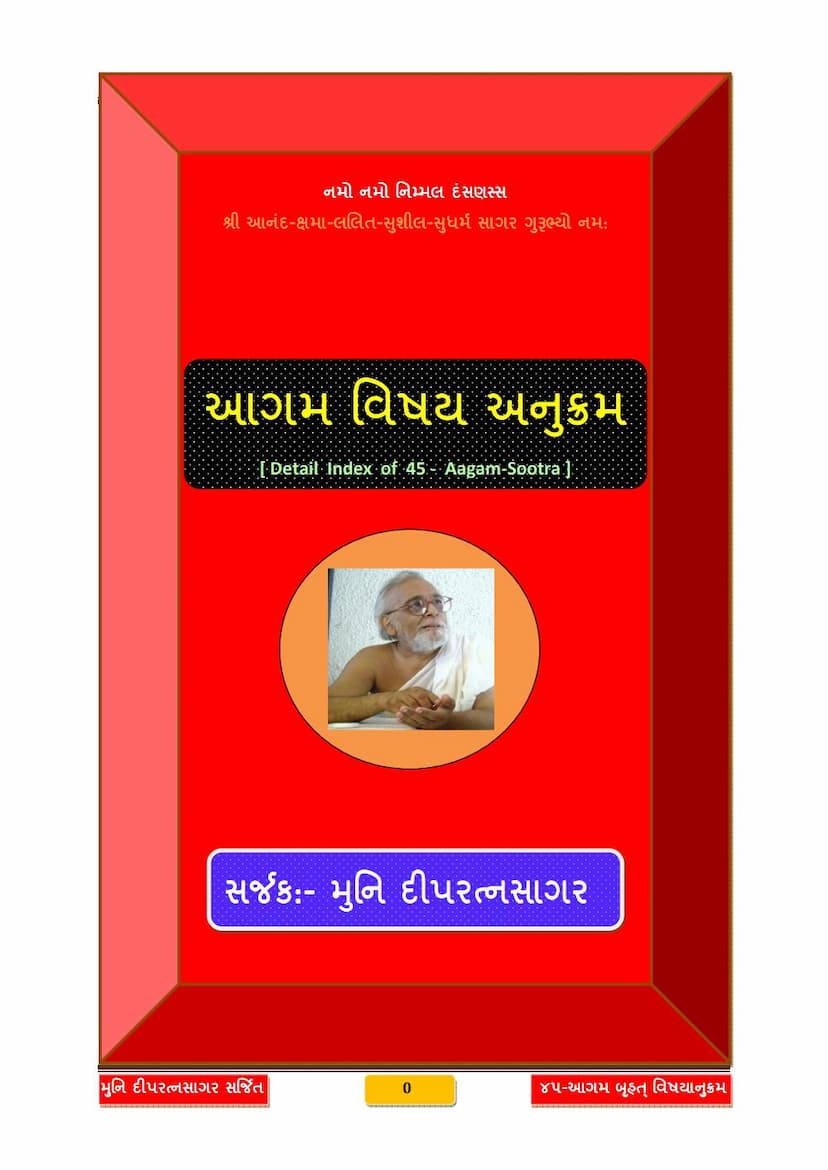Agam Vishay Anukram
Added to library: September 1, 2025

Summary
This Jain text, Agam Vishay Anukram (Detailed Index of 45 Agam Sutras), compiled by Muni Deepratnasagar, serves as a comprehensive guide and index to the 45 Agam Sutras of Jainism, specifically following the Shvetambar Murtipujak tradition.
Here's a breakdown of the text's content and purpose, based on the provided pages:
Core Purpose:
- Detailed Indexing: The primary goal of this work is to provide a highly detailed index of every sutra within the 45 Agam Sutras. It aims to pinpoint specific sections like Skandhas, Adhyayans, Shataks, Praabhritas, Vakshakaras, Dashas, or Padas, along with their objectives and the precise sutra sequence.
- Facilitating Study: The index is designed to help scholars and practitioners easily locate any desired topic or subject matter within the vast Agam literature. By referencing the index, users can quickly find the relevant Agam, its division (Shrutkandh, etc.), and the exact sutra number in any of Muni Deepratnasagar's published works.
- Accessibility Across Publications: The author emphasizes that all his 45 Agam publications (including original Prakrit, Gujarati translations, Hindi translations, annotated versions, and online resources) use a uniform sutra numbering and arrangement. This ensures that the index is applicable across all his published works, allowing for easy cross-referencing and comparative study.
- Deep and Comparative Understanding: The text highlights the benefit of being able to study a topic in different languages (Prakrit, Sanskrit, Gujarati, Hindi) and forms (original sutra or commentary), enabling a deeper and more comprehensive understanding of Jain philosophy.
Key Content and Structure:
-
Classification of Agamas (Page 4): The text begins by outlining the traditional Shvetambar classification of the 45 Agamas into six categories:
- 11 Angas: (e.g., Aayarang, Suyagada, Thana)
- 12 Upangas: (e.g., Uvavaiya, Rayapaseniya, Jivajivabhigama)
- 10 Painnas (Prakirnas): (e.g., Chaucaran, Mahapachchakkhan)
- 6 Chedas (Chedasutras): (e.g., Nisih, Vyahara, Mahanisih)
- 4 Mulasutras: (e.g., Avasyaka, Dasaveyaliya, Uttarajjayana)
- 2 Chulikas: (Nandi Sutra, Anuyogadvara)
-
Agam Index Structure (Pages 5-19 and beyond): The bulk of the document provides the detailed index. Each entry typically includes:
- A sequential number.
- The Agam section (Anga, Upanga, etc.).
- The name of the Agam Sutra.
- The corresponding page number in the author's publication.
- The subsequent pages (7 onwards) delve into the specific contents of each Agam Sutra, listing out the chapters (Shrutkandh), lessons (Adhyayan), and sub-sections or themes (Uddeshak) along with brief descriptions of the topics covered within each. For example, pages 7-19 detail the contents of the Aacharang Sutra, listing its Shrutkandh 1, Adhyayan 1, and its numerous Uddeshakas with specific subject points. This granular level of detail continues for other Agamas as well.
-
Author's Vision: Muni Deepratnasagar explains his motivation for creating this comprehensive index: seeing that all his Agam publications maintained a consistent sutra order, he decided to create a unified, detailed subject index for all 45 Agamas.
-
Study Methodology: The author provides a clear method for using the index:
- Identify the desired topic from the index.
- Note the number provided.
- Locate the Agam by its name in the header.
- Identify the specific section (Adhyayan, Uddeshak, etc.) using the provided numbering.
- This will pinpoint the exact sutra number containing the topic in any of his publications.
-
Benefits: The text emphasizes the following benefits of using this index:
- Ease of Research: Quickly find any subject matter across all 45 Agamas.
- Comparative Study: Easily compare topics across different Agamas or languages.
- In-depth Understanding: Facilitates thorough study of any chosen subject.
In essence, Agam Vishay Anukram is a scholarly tool that meticulously maps out the entire corpus of Shvetambar Agamic literature, making it an invaluable resource for anyone seeking to study or research the profound teachings contained within these sacred Jain texts. It's a testament to the author's dedication to making the Agamas accessible and understandable to a wider audience.